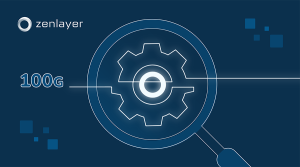Out-of-band management provides another way to connect to your device even when your primary connection goes down.
I recently had the chance to talk with our SD-WAN Product Director, Lancer Zhang, and he gave me a preview of an upcoming project he’s very excited about: fully integrating global out-of-band management (OOBM) with Zenlayer’s SD-WAN solutions. What is OOBM? How will Zenlayer’s implementation work? And just when and why would you use it? Read on to find out.
Why would you use Zenlayer’s OOBM?
The primary use for OOBM is troubleshooting. Picture this: it’s the middle of the night and you can’t reach your primary server. What’s going on? A power outage? A DDoS attack? Device failure? With in-band management, you have no way of knowing because you can’t access your device to find out. OOBM gives you an alternate path to connect and see what’s going on. It’s a great way to add another level of redundancy to your network.
Of course, when it comes to troubleshooting you need reliable access and you need it fast. Our OOBM with SD-WAN service will leverage Zenlayer’s Layer 2 backbone for international transit, thus guaranteeing stability with consistent latency and low packet loss. A traditional solution using public internet simply won’t have that kind of reliability.
What exactly is OOBM?
Out-of-band management allows you or your service provider to manage a device remotely, using a different connection than your main business connection (a.k.a. in-band management). There are a number of upsides: you can turn the device off and on from a remote location, install updates, and make other changes that would otherwise require a physical presence. However, remote OOBM usually requires a remote management card (RMC) to be installed. Not all devices have an RMC slot or are natively set up to handle OOBM.
How will Zenlayer’s OOBM work?
Our OOBM system will be built on our SD-WAN solutions. “It will be a managed service, like our SD-WAN product,” says Zhang. “Previously, you’d need to buy a console server and a separate management line to set up your OOBM system by yourself. You’d have to know what you’re doing. If you’re using Zenlayer, however, we’ll provide the OOBM and you can access your devices right from our portal.”
Just like Zenlayer’s existing SD-WAN services, there will be both automated alarms and a specialized team monitoring the systems at all times to ensure your OOBM connection is always ready and available to you. Zenlayer provides an API for easy integration with customers’ existing monitoring solutions.
Zhang highlights another difference that will make life a lot easier for users: you won’t need to know each device’s individual IP address to access them and make changes. The portal will already have that information and let you get to work right away. “Even if you shut down services in one data center and spin up three more on three different continents, you’ll still have instant access without having to keep track of a long list of devices and numbers.”
When will OOBM with SD-WAN be available?
“Right now we’re focused on internal testing, with plans to roll out in four data centers in China first,” says Zhang. “Feedback has been very good for the portal, with testers finding it friendly to operate.” As the rollout continues, the plan is to continue to gather feedback and data-usage statistics. All of this information will be used to further refine the service and portal until they have been polished to Zenlayer’s high standards. At that time, the OOBM service will be available for all Zenlayer customers worldwide.
Look forward to this new service from Zenlayer soon! If you want to be notified as soon as it becomes available, sign up for our monthly newsletter.







